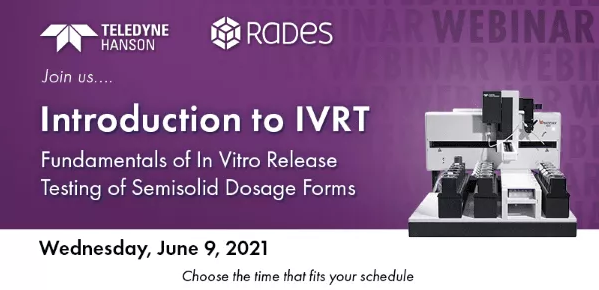Teledyne Hanson Research, în colaborare cu RaDes GmbH Germania, va prezenta miercuri, 9 iunie 2021 un webinar cu titlul „Introduction to IVRT: Fundamentals of In Vitro Release Testing of Semisolid Dosage Forms”. Participarea la prezentarea de aproximativ 45 de minute în limba engleză urmată de o sesiune interactivă de întrebări și răspunsuri este gratuită dar este necesară înregistrarea. Subiectele webinarului și opțiunile de înregistrare sunt următoarele:

| Europe
15:00 / 3 PM EEST |
The Americas
21:00 / 9 PM EEST |
Asia/PacRim
4:00 / 4:00 AM EEST, June 10 |
| REGISTER | REGISTER | REGISTER |
Evaluating release characteristics of active pharmaceutical ingredient (API) from a semisolid dosage form, whether for product development or quality control purposes, is best accomplished using vertical diffusion cell (VDC) instruments and methods. Obtaining test results that are meaningful for product development and acceptable by regulatory agencies requires a strong understanding of the factors affecting the accuracy and precision of in vitro release testing (IVRT). In this introductory-level webinar moderated by Keith Hamman, Vice President & General Manager of Teledyne Hanson, RaDes GmbH’s Sascha Gorissen, Lab Operations Manager, and Michael Herbig, CEO, will provide details on IVRT methods and best practices to ensure high quality results that fully comply with industry guidance, such as USP <1724> Semisolid Drug Products – Performance Tests.
Topics of discussion:
-
-
-
- What is diffusion and how is it calculated?
- Release test (IVRT) vs. permeation test (IVPT)
- IVRT receptor cell media and “back diffusion”
- IVRT test setup: membrane selection
- Determining API release rate
- IVRT method validation: sensitivity, linearity, specificity, and robustness
- Data validation: two-stage comparison testing of reference drug (R) vs. test formulation (T)
-
-

